Tag archives: food and science
RIKEN celebrates its centenary

Cool stuff: these liquid-helium tanks are used to chill the superconducting magnets at RIKEN’s accelerators in its Radioactive Ion Beam Facility. (Courtesy: Matin Durrani)
By Matin Durrani in Wako, Japan
It’s funny where chance encounters can lead.
Earlier this year, I was at a reception for science journalists at the Fenway Park baseball stadium in Boston, US, when I bumped into Jens Wilkinson, who works in the communications team at RIKEN – one of Japan’s biggest research institutions. He encouraged me to visit the lab, which was founded 100 years ago, should I ever find myself in Japan.
And so here I was at RIKEN’s headquarters in Wako, just north of Tokyo, on day two of my trip to gather material for the upcoming Physics World special report on Japan. Wako is home to the largest of RIKEN’s seven campuses, which together employ almost 2000 researchers.
Apart from celebrating its centenary this year, which included an event in downtown Tokyo with none other than Emperor Akihito, RIKEN has been in the news for its discovery of element 113. Created at the RIKEN Nishina Center for Accelerator-Based Sciemce by smashing zinc nuclei into a bismuth target, the element was last year officially named “nihonium” (Nh).
View all posts by this author | View this author's profile
The physics of bread, the quest for metallic hydrogen and adventures in LIGO land
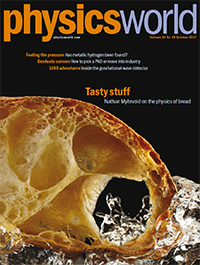 By Matin Durrani
By Matin Durrani
If you’re a student wondering whether to go into research or bag a job in industry, don’t miss our latest Graduate Careers special, which you can read in the October issue of Physics World.
Philip Judge from the US National Center for Atmospheric Research and his colleagues Isabel Lipartito and Robert Casini first describe how budding researchers should pick a PhD to work on. It’s vital as that first project can determine the trajectory of your future career.
But if your eyes are set on a job outside academia, careers guru Crystal Bailey from the American Physical Society runs through your options and calls on academics to learn more about what’s on offer so they can advise their students better.
If you’d rather just stick your head in the sand about your career options, however, then why not enjoy the cover feature of the October issue, in which former Microsoft chief tech officer and Intellectual Ventures boss Nathan Myhrvold discusses his massive new five-volume treatise Modernist Bread.
Mixing history and science – as well as the results of more than 1600 of his own experiments – the book is sure to be the last word on this foodstuff that humans have been baking for millennia.
Don’t miss either Jon Cartwright’s feature on the quest for metallic hydrogen.
Remember that if you’re a member of the Institute of Physics, you can read the whole of Physics World magazine every month via our digital apps for iOS, Android and Web browsers.
View all posts by this author | View this author's profile
Physics of food – the November 2016 issue of Physics World is now out
By Matin Durrani
If you love crisps – and frankly who doesn’t? – you’ll relish the cover feature of the latest issue of Physics World, in which features editor Louise Mayor tours the world’s biggest crisp factory at Leicester in the UK to see how physics is improving production of this yummy salty snack. The issue is now live in the Physics World app for mobile and desktop and will also be made available on physicsworld.com later this month.
Elsewhere in this special issue on physics and food, you can find out how electric fields could help to cut the fact from chocolate and discover why sound holds the key to our appreciation of what we eat.
You can also see how physicists – being masters of data-gathering, modelling and simulation – are ideally placed to develop products that are healthier, more nutritious and make more of our resources. Find out too how soft-matter physicists are crafting “functional” foods that promote feelings of fullness and satisfaction.
View all posts by this author | View this author's profile
The field that could improve your research ‘impact’
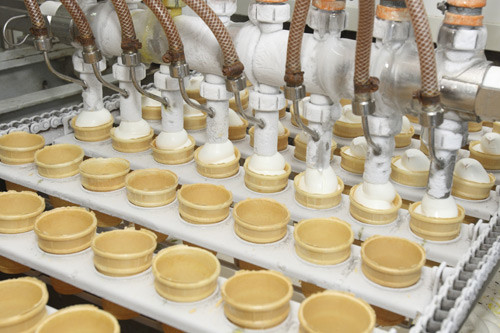
Where physics meets food: preparation of ice-cream in a factory. (Courtesy: iStockphoto/Leonid Shcheglov)
By Matin Durrani
As Physics World editor, I spend most of my time covering science that I have never been involved in. I might write articles about astrophysicists, interview atomic physicists or edit features by particle physicists, but it doesn’t mean I’ve ever done any research in those fields.
It was therefore a pleasant change last Friday to attend a summit organized by the Institute of Physics, which publishes Physics World, on physics in food manufacturing. Back in the 1990s, I did a PhD with Athene Donald at the Cavendish Laboratory in Cambridge on the physical properties of mixtures of gel-forming biopolymers – materials that apart from being interesting from a fundamental point of view are also relevant to the food industry.
Many foods, after all, are complex, multicomponent mixtures – and if you can understand how they behave, then you can create foods that are healthier, cheaper and perhaps even tastier too.
Cutting the fat from chocolate
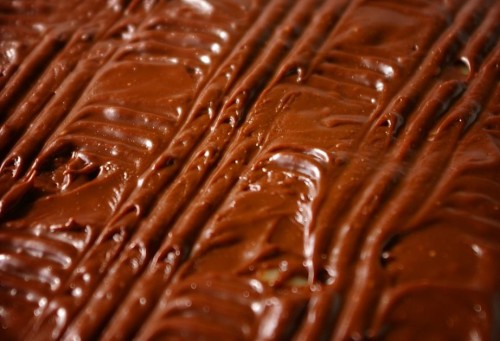
Go with the flow: physicist Rogjia Tao has a clever way to cut the fat in chocolate. (CC BY-SA 2.0/rore)
By Matin Durrani in Baltimore, Maryland, US
A couple of years ago my colleague James Dacey decided to give up eating chocolate, crisps, biscuits and cakes over Lent and it’s a virtuous – if very dull – decision I’ve been following every year since (even if James has long since strayed from the path of righteousness).
It was therefore with a dollop of smug satisfaction that I attended a talk at this year’s APS March meeting by Rongjia Tao – a physicist from Temple University in the US. He has developed a way of cutting the amount of fat in chocolate without, apparently, losing any of the taste.
Now, reducing the fat content in chocolate might seem straightforward – you just get rid of the fat, right? But it’s a harder problem than you’d think for chocolate manufacturers, who have to send liquid chocolate – a suspension of spherical cocoa particles in a melted fat of cocoa butter and other oils – down pipes and tubes.
Chocolate dynamics, recycling urine, the hipster-physicist look and more

Cocoa conch: a chocolate’s distinctive flavour and texture comes from “conching”. (Courtesy: iStock/deyangeorgiev)
By Michael Banks, Tushna Commissariat and Matin Durrani
Chocolate, the food of the gods, is more popular now as a sweet treat than ever before. And while more and more people know their 70% cocoa from their truffles, “lecithin” still isn’t a word that pops up often. It is an ingredient that plays a key role in chocolate-making and other foods. But this fatty substance has long confounded food-scientists and confectioners alike – we don’t know how this ingredient works on a molecular level and confectioners have had to rely on observations and trial-and-error methods to perfect recipes.
Now, though, chocolatiers have had help from an unexpected field – that of molecular biology – to figure out chocolate “conching” – the part of the chocolate-making process where aromatic sensation, texture and “mouthfeel” are developed. In a special issue on “The Physics of Food” published in the Journal of Physics D: Applied Physics, Heiko Briesen and colleagues at Technische Universität München, Germany, use molecular dynamics to model and simulate how lecithin molecules, made from different sources, attach to the sugar surface in cocoa butter. “I’m quite confident molecular dynamics will strongly support food science in the future” says Briesen.
View all posts by this author | View this author's profile
Ice cream that changes colour, tag-team parenting and the ITER director-general hits back

Shades of pink: the Xamaleón ice cream in action. (Courtesy: IceXperience)
By Hamish Johnston
It has been a cracker of a summer here in south-west England, with lots of sunshine and temperatures in the mid-twenties just about every day. Not surprisingly, I have been eating my fair share of ice cream, but unlike this concoction whipped up by a physicist-turned-chef in Spain, the stuff you get in Bristol does not change colour when you lick it!
Microwave pockets, space station strife and dreaming of Mars
By Hamish Johnston
The physics of how the contents of a microwaved pastry can become “hotter than the Sun” is the subject of an entertaining and informative blog entry by Ethan Siegel. He looks at the physics of heating “microwave pockets”, those roof-of-your-mouth-scalding savoury treats that appeared on shelves in the 1980s. He explains why the outer portion of a pocket can be extremely hot, while the interior remains frozen – and why pockets often explode when heated through.
Siegel’s been a bit cheeky and republished this entry from 2009, but I suppose it’s timeless and I’m sure you can still buy microwave pockets somewhere! His blog is called Starts With a Bang and the entry is entitled “Throwback Thursday: The physics of hot pockets”.
As the crisis in the Ukraine drags on, scientists are beginning to worry about the effect it could have on scientific collaborations involving Russia and the West. Several websites are reporting that Russia is threatening to ban US astronauts from the shuttles that travel to the International Space Station (ISS). Indeed, the Independent quotes Russia’s deputy prime minister Dmitry Rogozin as saying that it would be possible for Russia to independently operate its portion of the ISS, while the US would not be able to do so. Indeed both toilets on the ISS are Russian, so it could get very messy up there!
Cakes that are out of this world, what’s on Andre Geim’s iPod and who’s the April fool?
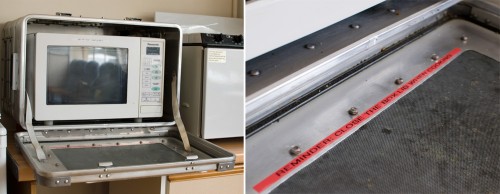
The joke’s on me: click on the image for a larger version where you can see the instruction for users
By Hamish Johnston
On Tuesday I was feeling particularly pleased with myself over the April Fool’s piece that I penned. It was about a fictitious microwave-oven ban organized by radio astronomers at the UK’s Jodrell Bank Observatory. But now it looks like I might have a bit of microwaved egg on my face because two of my colleagues visited Jodrell Bank this week and guess what? Astronomers there have built a Faraday cage around the microwave in their tearoom to stop it from interfering with their equipment. Louise Mayor took the above photos: click on the image to read the reminder to microwave users.
View all posts by this author | View this author's profile
Cress on the Moon, more physics books, a radioactive ‘foot’ and more
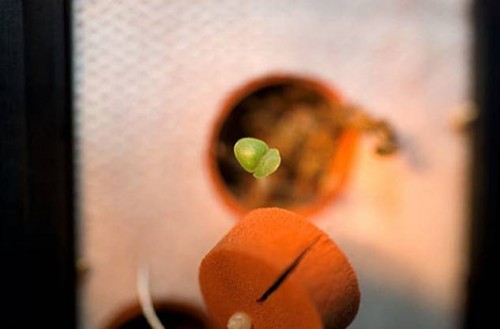
A small green sprout of cinnamon basil, growing on board the International Space Station in 2007. (Courtesy: NASA)
By Tushna Commissariat
Early this week, a story in the Telegraph caught our eye – NASA is planning on sending turnip, cress and basil seeds to the Moon to germinate them! This is most definitely not the first time that plants have been grown beyond the realms of Earth. Indeed, potatoes were grown on board during a 1995 Space Shuttle mission and many experiments involving germinating seeds were done on the International Space Station. The goal of these studies was to understand the effects of microgravity on plant growth. But now, NASA plans to take this one step further in 2015 with their Moon Express mission, which will include the Lunar Plant Growth Chamber that will carry seeds and enough air and nutrients to allow the seeds to sprout and grow. Will fresh salad be on an astronaut’s menu soon?
